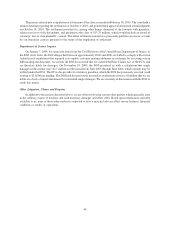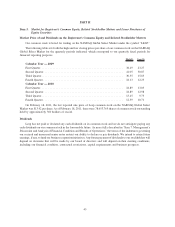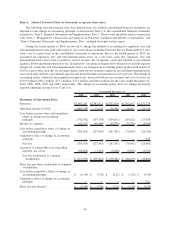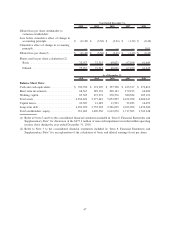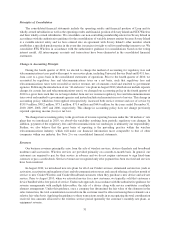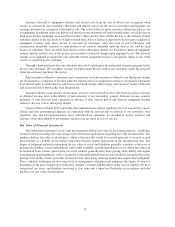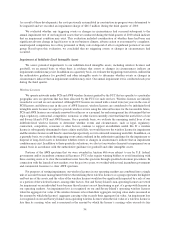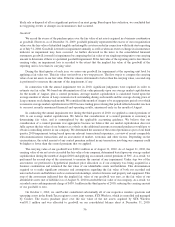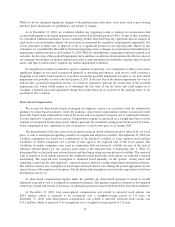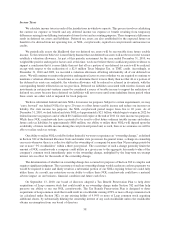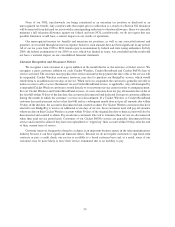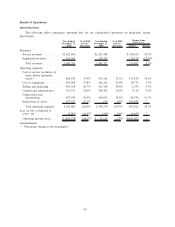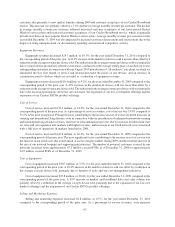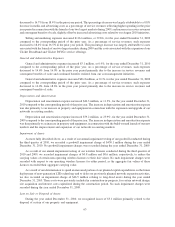Cricket Wireless 2010 Annual Report Download - page 60
Download and view the complete annual report
Please find page 60 of the 2010 Cricket Wireless annual report below. You can navigate through the pages in the report by either clicking on the pages listed below, or by using the keyword search tool below to find specific information within the annual report.As a result of these developments, the costs previously accumulated in construction-in-progress were determined to
be impaired and we recorded an impairment charge of $46.5 million during the third quarter of 2010.
We evaluated whether any triggering events or changes in circumstances had occurred subsequent to the
annual impairment test of our long-lived assets that we conducted during the third quarter of 2010 which indicate
that an impairment condition may exist. This evaluation included consideration of whether there had been any
significant adverse change in legal factors or in our business climate, adverse action or assessment by a regulator,
unanticipated competition, loss of key personnel or likely sale or disposal of all or a significant portion of an asset
group. Based upon this evaluation, we concluded that no triggering events or changes in circumstances had
occurred.
Impairment of Indefinite-Lived Intangible Assets
We assess potential impairments to our indefinite-lived intangible assets, including wireless licenses and
goodwill, on an annual basis or when there is evidence that events or changes in circumstances indicate an
impairment condition may exist. In addition on a quarterly basis, we evaluate the triggering event criteria outlined in
the authoritative guidance for goodwill and other intangible assets to determine whether events or changes in
circumstances indicate that an impairment condition may exist. Our annual impairment test is conducted each year
during the third quarter.
Wireless Licenses
We operate networks under PCS and AWS wireless licenses granted by the FCC that are specific to a particular
geographic area on spectrum that has been allocated by the FCC for such services. Wireless licenses are initially
recorded at cost and are not amortized. Although FCC licenses are issued with a stated term (ten years in the case of
PCS licenses and fifteen years in the case of AWS licenses), wireless licenses are considered to be indefinite-lived
intangible assets because we expect to provide wireless service using the relevant licenses for the foreseeable future,
PCS and AWS licenses are routinely renewed for either no or a nominal fee and management has determined that no
legal, regulatory, contractual, competitive, economic or other factors currently exist that limit the useful lives of our
and Savary Island’s PCS and AWS licenses. On a quarterly basis, we evaluate the remaining useful lives of our
indefinite-lived wireless licenses to determine whether events and circumstances, such as legal, regulatory,
contractual, competitive, economic or other factors, continue to support an indefinite useful life. If a wireless
license is subsequently determined to have a finite useful life, we would first test the wireless license for impairment
and the wireless license would then be amortized prospectively over its estimated remaining useful life. In addition, on
a quarterly basis, we evaluate the triggering event criteria outlined in the authoritative guidance for the impairment or
disposal of long-lived assets to determine whether events or changes in circumstances indicate that an impairment
condition may exist. In addition to these quarterly evaluations, we also test our wireless licenses for impairment on an
annual basis in accordance with the authoritative guidance for goodwill and other intangible assets.
Portions of the AWS spectrum that we were awarded in Auction #66 were subject to use by U.S. federal
government and/or incumbent commercial licensees. FCC rules require winning bidders to avoid interfering with
these existing users or to clear the incumbent users from the spectrum through specified relocation procedures. In
connection with the launch of new markets over the past two years, we worked with several incumbent government
and commercial licensees to clear AWS spectrum.
For purposes of testing impairment, our wireless licenses in our operating markets are combined into a single
unit of account because management believes that utilizing these wireless licenses as a group represents the highest
and best use of the assets, and the value of the wireless licenses would not be significantly impacted by a sale of one
or a portion of the wireless licenses, among other factors. Our and Savary Island’s non-operating licenses are tested
for impairment on an individual basis because these licenses are not functioning as part of a group with licenses in
our operating markets. An impairment loss is recognized on our and Savary Island’s operating wireless licenses
when the aggregate fair value of the wireless licenses is less than their aggregate carrying value and is measured as
the amount by which the licenses’ aggregate carrying value exceeds their aggregate fair value. An impairment loss
is recognized on our and Savary Island’s non-operating wireless licenses when the fair value of a wireless license is
less than its carrying value and is measured as the amount by which the license’s carrying value exceeds its fair
54


